The Dammar Gum Market is estimated to be valued at USD 2.4 billion in 2025 and is projected to reach USD 3.6 billion by 2035, registering a compound annual growth rate (CAGR) of 4.1% over the forecast period.
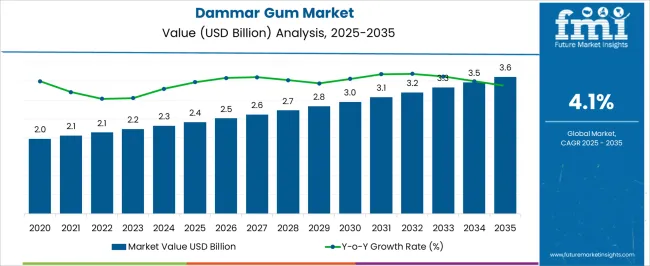
| Metric | Value |
|---|---|
| Dammar Gum Market Estimated Value in (2025 E) | USD 2.4 billion |
| Dammar Gum Market Forecast Value in (2035 F) | USD 3.6 billion |
| Forecast CAGR (2025 to 2035) | 4.1% |
The Dammar Gum market is experiencing steady growth driven by its extensive applications across food, coatings, pharmaceuticals, and other industries that demand natural resin products. The current market scenario reflects increasing adoption due to the rising preference for natural, biodegradable, and non-toxic additives in various formulations. Growing consumer awareness about health and safety, coupled with a shift towards sustainable ingredients, has further accelerated demand.
Investments in processing technologies that improve purity, color consistency, and solubility are also enabling broader utilization across industrial and commercial applications. The market outlook is shaped by the potential for expanded use in emerging sectors such as functional foods, nutraceuticals, and eco-friendly coatings.
Additionally, the long shelf-life and natural origin of Dammar Gum have encouraged its adoption as a stable and reliable raw material As global demand for plant-derived additives continues to rise, Dammar Gum is positioned to witness continued growth, with opportunities to innovate in applications that require natural binding, glazing, and stabilizing properties.
The dammar gum market is segmented by source, color, end use, application, and geographic regions. By source, dammar gum market is divided into Shorea, Agathis, Hopea, and Other. In terms of color, dammar gum market is classified into White, Brown, Grey-Brown, Pale Yellow, and Other. Based on end use, dammar gum market is segmented into Food, Incense, Varnish, Dentistry, Pharmaceutical, and Other (Paint, Ink Etc.). By application, dammar gum market is segmented into Glazing Agent, Stabilizer, Clouding Agent, Adhesion, and Other (Water-Repellant, Fume Resistance Etc.). Regionally, the dammar gum industry is classified into North America, Latin America, Western Europe, Eastern Europe, Balkan & Baltic Countries, Russia & Belarus, Central Asia, East Asia, South Asia & Pacific, and the Middle East & Africa.
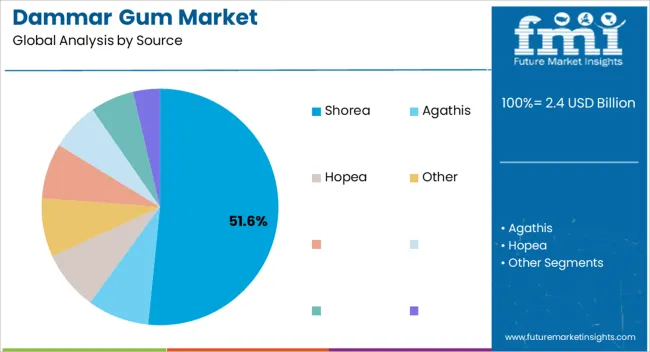
The Shorea source segment is projected to hold 51.60% of the Dammar Gum market revenue share in 2025, establishing it as the dominant source type. This leading position is attributed to the higher yield and quality of resin obtained from Shorea trees, which results in superior physical and chemical properties suitable for multiple industrial applications. The resin is preferred for its uniform composition, ease of processing, and consistent performance when used in food, coatings, and pharmaceutical products.
Adoption has been accelerated due to increasing demand from commercial food manufacturers who rely on natural resins as stabilizers, glazing agents, and protective coatings. The sustainable harvesting practices associated with Shorea trees have also enhanced its attractiveness to environmentally conscious buyers.
The growth of this segment has been reinforced by the combination of supply reliability, product purity, and performance consistency, which collectively drive adoption in markets seeking natural and safe alternatives Continued investment in sustainable cultivation and harvesting methods is expected to support the segment’s long-term expansion.
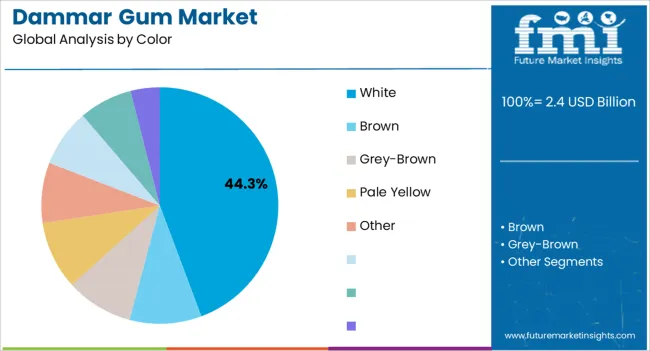
The white color segment is anticipated to account for 44.30% of the Dammar Gum market revenue share in 2025, making it the leading color type. This dominance is largely due to the preference for light-colored resins in food and cosmetic applications, where purity and aesthetic appeal are critical. White Dammar Gum is favored because it can be easily incorporated without affecting the color or clarity of the final product.
Its high visual quality and minimal impurity content have encouraged adoption in premium formulations and natural product lines. The segment’s growth has been further propelled by the demand from manufacturers who require visually consistent raw materials to maintain product standards.
Additionally, the ability of white Dammar Gum to provide desirable textural and stabilizing properties has reinforced its position as the preferred choice across multiple applications The continued focus on natural and clean-label products is expected to drive further expansion of this segment in the coming years.
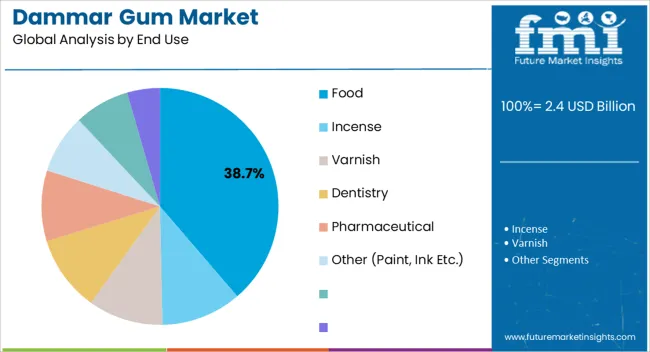
The food end-use segment is expected to hold 38.70% of the Dammar Gum market revenue share in 2025, making it the largest end-use category. This leadership is being driven by the growing incorporation of natural resins as stabilizers, glazing agents, and carriers in processed foods, confectionery, and beverages.
The segment’s growth is supported by rising consumer demand for clean-label and naturally derived ingredients, which has encouraged manufacturers to replace synthetic additives with Dammar Gum. The functional properties of Dammar Gum, including its ability to improve texture, protect against moisture, and extend shelf-life, have further increased its adoption in the food industry.
Additionally, regulatory support for natural additives in many regions has reinforced the preference for Dammar Gum in food formulations Increasing innovation in food processing techniques and the development of value-added natural products are expected to sustain the segment’s market leadership, offering opportunities for expansion across diverse food categories.
Dammar gum is a resin mostly found in India and East Asian countries. Dammar gum is also known as Dammar or Damar gum. Dammar gum is a dried exudate derived from Dipterocarpaceae family trees, by tapping the trees or collected in the form of fossil from the ground. The content of the dammar gum is triterpenoid resins and its oxidation products such as dammarane, oleaonic acid, oleanane, and dammarenolic acid. Due to its clouding, glazing, stabilizing, and other properties it finds uses in industries such as food, paint, ink, varnish, and lacquer. Dammar gum resin is used in incense industry because it emits light lemony scent.
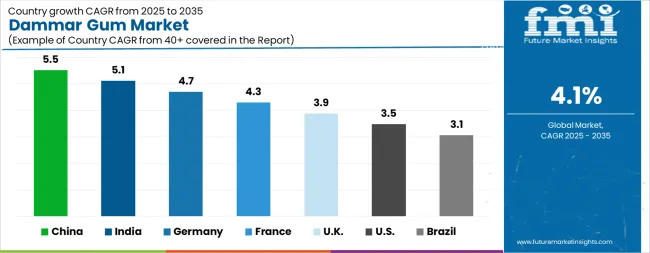
| Country | CAGR |
|---|---|
| China | 5.5% |
| India | 5.1% |
| Germany | 4.7% |
| France | 4.3% |
| UK | 3.9% |
| USA | 3.5% |
| Brazil | 3.1% |
The Dammar Gum Market is expected to register a CAGR of 4.1% during the forecast period, exhibiting varied country level momentum. China leads with the highest CAGR of 5.5%, followed by India at 5.1%. Developed markets such as Germany, France, and the UK continue to expand steadily, while the USA is likely to grow at consistent rates. Brazil posts the lowest CAGR at 3.1%, yet still underscores a broadly positive trajectory for the global Dammar Gum Market. In 2024, Germany held a dominant revenue in the Western Europe market and is expected to grow with a CAGR of 4.7%. The USA Dammar Gum Market is estimated to be valued at USD 841.5 million in 2025 and is anticipated to reach a valuation of USD 1.2 billion by 2035. Sales are projected to rise at a CAGR of 3.5% over the forecast period between 2025 and 2035. While Japan and South Korea markets are estimated to be valued at USD 121.7 million and USD 73.3 million respectively in 2025.
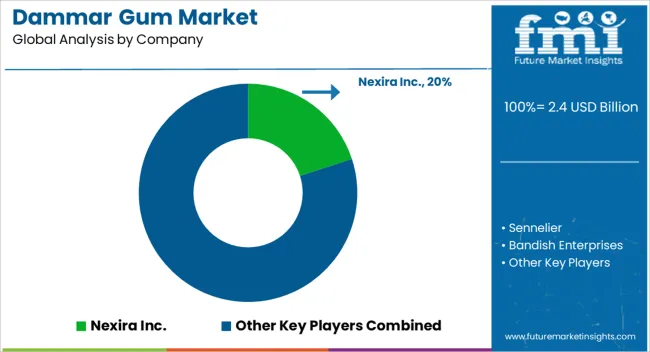
| Item | Value |
|---|---|
| Quantitative Units | USD 2.4 Billion |
| Source | Shorea, Agathis, Hopea, and Other |
| Color | White, Brown, Grey-Brown, Pale Yellow, and Other |
| End Use | Food, Incense, Varnish, Dentistry, Pharmaceutical, and Other (Paint, Ink Etc.) |
| Application | Glazing Agent, Stabilizer, Clouding Agent, Adhesion, and Other (Water-Repellant, Fume Resistance Etc.) |
| Regions Covered | North America, Europe, Asia-Pacific, Latin America, Middle East & Africa |
| Country Covered | United States, Canada, Germany, France, United Kingdom, China, Japan, India, Brazil, South Africa |
| Key Companies Profiled | Nexira Inc., Sennelier, Bandish Enterprises, Starlight, William Bernstein Company, and T. Samiraschem Indonesia |
The global dammar gum market is estimated to be valued at USD 2.4 billion in 2025.
The market size for the dammar gum market is projected to reach USD 3.6 billion by 2035.
The dammar gum market is expected to grow at a 4.1% CAGR between 2025 and 2035.
The key product types in dammar gum market are shorea, agathis, hopea and other.
In terms of color, white segment to command 44.3% share in the dammar gum market in 2025.






Our Research Products

The "Full Research Suite" delivers actionable market intel, deep dives on markets or technologies, so clients act faster, cut risk, and unlock growth.

The Leaderboard benchmarks and ranks top vendors, classifying them as Established Leaders, Leading Challengers, or Disruptors & Challengers.

Locates where complements amplify value and substitutes erode it, forecasting net impact by horizon

We deliver granular, decision-grade intel: market sizing, 5-year forecasts, pricing, adoption, usage, revenue, and operational KPIs—plus competitor tracking, regulation, and value chains—across 60 countries broadly.

Spot the shifts before they hit your P&L. We track inflection points, adoption curves, pricing moves, and ecosystem plays to show where demand is heading, why it is changing, and what to do next across high-growth markets and disruptive tech

Real-time reads of user behavior. We track shifting priorities, perceptions of today’s and next-gen services, and provider experience, then pace how fast tech moves from trial to adoption, blending buyer, consumer, and channel inputs with social signals (#WhySwitch, #UX).

Partner with our analyst team to build a custom report designed around your business priorities. From analysing market trends to assessing competitors or crafting bespoke datasets, we tailor insights to your needs.
Supplier Intelligence
Discovery & Profiling
Capacity & Footprint
Performance & Risk
Compliance & Governance
Commercial Readiness
Who Supplies Whom
Scorecards & Shortlists
Playbooks & Docs
Category Intelligence
Definition & Scope
Demand & Use Cases
Cost Drivers
Market Structure
Supply Chain Map
Trade & Policy
Operating Norms
Deliverables
Buyer Intelligence
Account Basics
Spend & Scope
Procurement Model
Vendor Requirements
Terms & Policies
Entry Strategy
Pain Points & Triggers
Outputs
Pricing Analysis
Benchmarks
Trends
Should-Cost
Indexation
Landed Cost
Commercial Terms
Deliverables
Brand Analysis
Positioning & Value Prop
Share & Presence
Customer Evidence
Go-to-Market
Digital & Reputation
Compliance & Trust
KPIs & Gaps
Outputs
Full Research Suite comprises of:
Market outlook & trends analysis
Interviews & case studies
Strategic recommendations
Vendor profiles & capabilities analysis
5-year forecasts
8 regions and 60+ country-level data splits
Market segment data splits
12 months of continuous data updates
DELIVERED AS:
PDF EXCEL ONLINE
Gum Rosin Market Size and Share Forecast Outlook 2025 to 2035
Gummed Tape Market Size and Share Forecast Outlook 2025 to 2035
Gummy Supplements Market Size and Share Forecast Outlook 2025 to 2035
Gum Arabic Market Analysis – Size, Share, and Forecast Outlook 2025 to 2035
Gummy Market Analysis by Product, Ingredient, End-Use, Distribution Channel, and Region - Forecast through 2025 to 2035
Gum Turpentine Oil Market Growth - Trends & Forecast 2025 to 2035
Gum Hydrocolloid Market Analysis by Product Type, Source, and Region through 2035
Key Companies & Market Share in the Gummed Tape Sector
Evaluating Gum Fiber Market Share & Provider Insights
Gum Content Tester Market
CBD Gummies Market Analysis - Size, Share and Forecast Outlook 2025 to 2035
Pre-Gummed Labels Market Growth - Demand & Forecast 2025 to 2035
Guar Gum Market Size and Share Forecast Outlook 2025 to 2035
Guar Gum for Construction Market Size and Share Forecast Outlook 2025 to 2035
Tara Gum Market Size and Share Forecast Outlook 2025 to 2035
Sleep Gummy Market Analysis by Primary Ingredient, Customer Orientation, Pack Size and Product Claim Through 2035
Paper Gummed Tape Market Growth - Demand & Forecast 2025 to 2035
CoQ10 Gummies Market Analysis by Source, Distribution Channels, and Key Regions Through 2035
Ester Gums Market Growth – Trends & Forecast 2025 to 2035
Biotin Gummies Market Analysis - Size and Share Forecast Outlook 2025 to 2035

Thank you!
You will receive an email from our Business Development Manager. Please be sure to check your SPAM/JUNK folder too.
Chat With
MaRIA